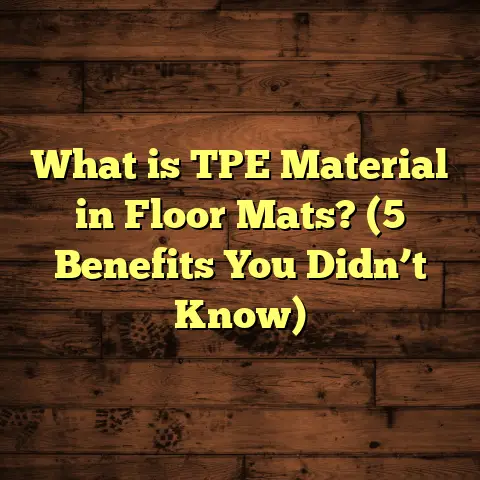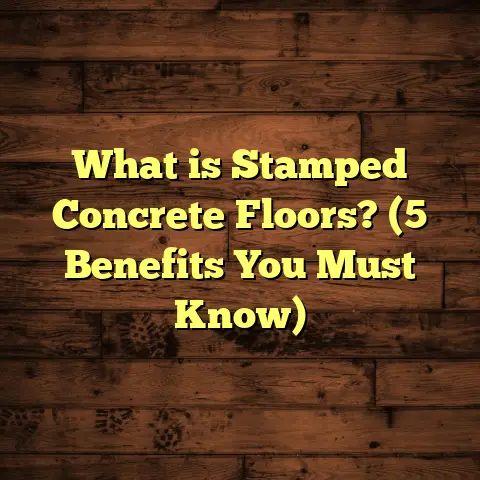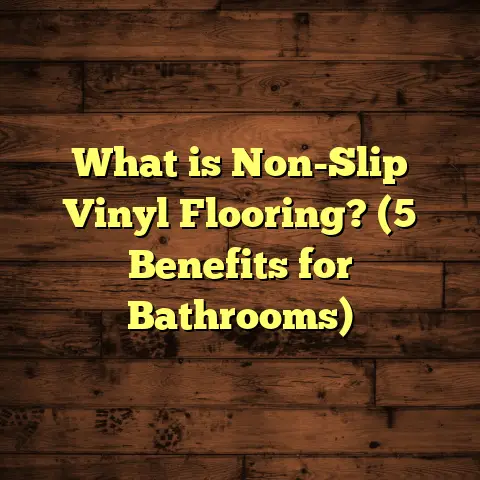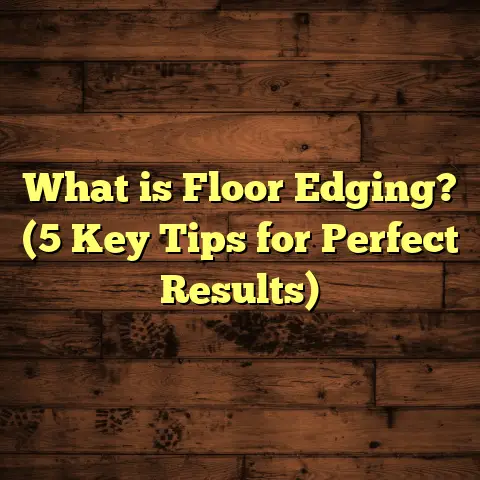What is My House Floor Made Of? (5 Key Materials Explained)
I remember the moment I first stepped into that old house I was about to renovate. The floors were a mess — scratched up hardwood in some spots, worn-out carpet in others, and patches where the original flooring had been ripped up and replaced with cheap linoleum. It was a far cry from what I wanted for my home. Fast forward a few months after tearing out the old floors, picking materials carefully, and a lot of elbow grease, the whole place felt transformed. The new floors weren’t just surfaces to walk on; they became the foundation of the home’s atmosphere. They changed how I felt every time I walked in.
That experience taught me a lot about floors — how different materials behave, what suits different spaces, and why knowing what your floor is made of matters more than you might think.
What is My House Floor Made Of?
This is the kind of question that can start with simple curiosity but quickly turns practical. Your floor affects everything from your home’s comfort to its value. It also impacts maintenance routines and renovation costs.
When I say “what your floor is made of,” I’m referring to the base material or covering that makes up the walking surface in your home. If you don’t know this already, you might be guessing or making assumptions that lead to poor care or costly mistakes.
In my years of working as a flooring contractor and homeowner juggling multiple projects, I’ve narrowed down five key materials you’ll likely encounter:
- Hardwood
- Laminate
- Vinyl
- Tile
- Carpet
Each comes with unique traits, maintenance needs, and price points. I’ll share what I’ve learned about each—sometimes from personal failures and sometimes from professional wins.
Hardwood Floors: The Richness Beneath Your Feet
Hardwood is often considered the “gold standard” in flooring for good reasons. When I installed hardwood floors in my own place for the first time, it was an emotional moment. The warmth and natural beauty brought an instant coziness that no other flooring can match.
Why Hardwood Stands Out
The thing about hardwood floors is that they’re made from solid pieces of wood—usually oak, maple, cherry, or walnut. This means you’re literally walking on centuries-old trees that have been crafted into beautiful planks.
From my experience:
- Durability: Hardwood can survive decades—even over a century with proper care.
- Refinishing: Unlike most other floors, hardwood can be sanded down and refinished multiple times, which means scratches and dents aren’t permanent.
- Value Booster: Homes with hardwood floors sell faster and often at higher prices. National real estate data shows homes with hardwood can increase resale value by up to 2-3%.
What I Learned About Hardwood
One lesson I learned early was about moisture control. Wood expands and contracts based on humidity levels. If you live somewhere humid or with big temperature swings, you need to keep your home’s humidity balanced—ideally between 30% and 50%. Otherwise, expect gaps or warping.
When installing hardwood, I always recommend using a professional-grade vapor barrier underneath if you’re on a concrete slab or basement level. This prevents moisture from seeping up and ruining your floor.
Cost Considerations
Hardwood prices vary widely depending on species and grade. On average:
- Materials: $5 to $15+ per sq ft
- Installation: $3 to $8 per sq ft
So for a 1,000 sq ft room, expect $8,000 – $23,000 roughly all-in.
A Personal Story
Once, I worked on a house where the client wanted to install reclaimed hardwood from an old barn. It was beautiful but came with hidden nails and uneven thickness. We had to spend extra time prepping each plank. The end result? Stunning floors with so much character that no new wood could match. But it taught me that not all hardwood is equal—quality matters and prep costs add up.
Laminate Flooring: The Affordable Lookalike
Laminate often gets overlooked or dismissed as cheap knockoff flooring. But I’ve found it can be an excellent choice for many situations—especially if you’re on a budget but want the look of wood.
What Makes Laminate Different?
Laminate is a composite product made of fiberboard core topped with a photographic layer that mimics wood grain or stone. Over that is a protective wear layer that makes laminate tougher than some hardwood finishes when it comes to scratches.
Why I Recommend Laminate at Times
- Cost-effective: Laminate is generally less expensive than hardwood.
- DIY Friendly: Most laminates use click-lock installation systems that make it possible for homeowners to do it themselves.
- Scratch Resistance: Great for homes with pets or kids because it resists scratches better than softer woods.
I once helped a friend install laminate in their basement family room. The click-lock system made the job go quickly over a properly leveled floor.
Key Tips for Laminate Floors
- Level your subfloor perfectly before installation because laminate does not like uneven surfaces.
- Use an underlayment for moisture barrier and sound reduction.
- Avoid standing water; laminate is not waterproof like vinyl.
Pricing Insights
Laminate flooring typically costs:
- Materials: $1 to $5 per sq ft
- Installation: $2 to $6 per sq ft
So a 1,000 sq ft room might run between $3,000 – $11,000 total.
My Takeaway
Not all laminate is created equally. Higher-end brands have thicker wear layers and better looks that come closer to real hardwood. For rentals or quick renovations, laminate is often a solid choice.
Vinyl Flooring: Versatile and Water-Friendly
Vinyl has evolved massively over the years — no longer just plain sheets stuck on floors but textured planks and tiles that mimic wood, stone, and ceramic beautifully.
Why Vinyl Stands Out
Vinyl’s biggest advantage is being waterproof. From my projects in kitchens and bathrooms, vinyl offers durability where moisture is a constant threat.
I installed vinyl plank flooring in a rental kitchen once, and the tenants loved how warm it felt compared to tile but didn’t worry about spills.
What I’ve Learned About Vinyl
- Smooth subfloors are crucial since vinyl reflects every bump.
- Avoid harsh chemicals; mild soap works best.
- Some luxury vinyl products offer additional comfort layers.
According to industry data, vinyl flooring sales have grown by roughly 7% annually as designs improve.
Cost Breakdown
Vinyl generally runs:
- Materials: $2 to $7 per sq ft
- Installation: $1.50 to $4 per sq ft
Total for 1,000 sq ft: roughly $3,500 – $11,000.
My Personal Insight
I appreciate vinyl’s flexibility—a great choice for budget buys or areas prone to spills without sacrificing style.
Tile Flooring: Durable and Stylish Choices
Tile floors are everywhere in kitchens, bathrooms, mudrooms, and entryways—and for good reason.
Why Tile?
Ceramic or porcelain tiles offer extreme durability and water resistance. They come in endless styles—from rustic terracotta to glossy marble looks.
My Experience Installing Tile
Tile installation requires patience and precision. I remember one client who wanted big 24×24 inch tiles without reinforcing their subfloor. A few months later? Cracked tiles everywhere.
Lesson learned: always prepare your subfloor correctly!
Maintenance Tips
Sealing grout prevents stains and water damage. And if you want luxury? Heated tile floors create cozy winter mornings but expect professional installation costs.
Costs Involved
Tile flooring costs vary:
- Materials: $3 – $15+ per sq ft
- Installation: $7 – $15 per sq ft (tile labor is labor-intensive)
For 1,000 sq ft: $10,000 – $30,000+ depending on tile choice.
Carpet Floors: Softness That Makes a Difference
Carpet brings unmatched comfort underfoot and noise absorption that hard surfaces can’t deliver.
Why Choose Carpet?
Carpets soften footsteps, warm cold rooms, and come in various textures—from plush to low-pile commercial styles.
I’ve installed carpets ranging from affordable synthetic blends to luxurious wool options for clients with different budgets.
Key Carpet Insights
- Use stain-resistant fibers in high traffic areas.
- Padding extends carpet life.
- Professional cleaning every 12-18 months keeps carpets fresh.
Price Range
Carpet installation generally costs:
- Materials: $1 – $5 per sq ft
- Installation: $1 – $3 per sq ft
So for 1,000 sq ft expect around $2,000 – $8,000 total.
How I Use Tools Like FloorTally to Manage Flooring Projects
Before using FloorTally, cost estimation felt like guesswork mixed with multiple quotes from different suppliers and contractors. That meant wasted time and sometimes surprises when final bills came in.
FloorTally helped me by consolidating calculations based on local labor rates and actual material costs. It even factors waste material percentages so I never had to buy too little or too much again.
When I enter room dimensions and select materials—whether hardwood or vinyl—it spits out detailed cost breakdowns instantly. This transparency helps me budget better and make smarter decisions about upgrades or compromises.
If you’re tackling a flooring project yourself or managing contractors, try inputting your project details into such calculators before buying anything. It saves headaches down the road—and better aligns expectations between you and installers.
How to Identify Your Floor Material at Home
Not sure what your floor is made of? Here’s how I tell:
- Warm & soft? Probably carpet.
- Looks like wood but feels plastic? Most likely laminate.
- Cold with grout lines? Tile.
- Natural wood grain with imperfections? Hardwood.
- Waterproof with cushioned feel? Vinyl probably.
Look closely at edges where flooring might be exposed (like closets). Pull back a trim piece if needed—but carefully!
Caring for Each Floor Type Based on My Experience
Beyond knowing what your floor is made of, caring for it right extends its life dramatically.
| Flooring Type | Care Tips | My Observations |
|---|---|---|
| Hardwood | Keep humidity balanced; clean spills fast; use soft brooms | Hardwood scratches but refinishes well |
| Laminate | Avoid moisture; vacuum regularly; use underlayment | Durable but won’t handle water well |
| Vinyl | Clean with mild soap; smooth subfloor needed; avoid sharp objects | Great in wet areas with easy maintenance |
| Tile | Seal grout; avoid dropping heavy objects; clean regularly | Long-lasting but grout needs upkeep |
| Carpet | Vacuum often; professional cleaning yearly; use padding | Soft but stains easily without care |
Final Thoughts: Your Floor Is More Than Just Flooring
Understanding what your floor is made of isn’t just trivia—it shapes how you live in your home daily. It affects comfort, aesthetics, maintenance routines, budgets, and even your home’s long-term value.
When I look back at my own projects—from worn-out hardwood rescues to budget-friendly laminate installs—I realize each floor tells a story about choices made for lifestyle needs and budgets at the time.
If you want me to help identify or plan your next flooring project just ask! Knowing your floor’s material sets you up for success in keeping it beautiful for years ahead.
Would you like me to help you break down costs for a specific room or suggest maintenance routines tailored exactly to your floor type? Just say the word!





